Nursing Assignment: Language Barrier in Healthcare - Solutions
VerifiedAdded on 2023/01/23
|10
|3068
|67
Report
AI Summary
This nursing assignment report investigates the critical issue of language barriers in healthcare, focusing on communication challenges between nurses and culturally and linguistically diverse (CALD) patients. The report begins by highlighting the significance of effective communication in nursing and the difficulties posed by language barriers. It outlines the research aim, objectives, and questions, including an examination of the causes of language barriers and potential solutions. The research employs a mixed methodology, combining quantitative surveys with nurses and clients, and qualitative interviews with healthcare personnel to gather comprehensive data. The literature review synthesizes existing research, discussing the impact of language barriers on patient care, the effectiveness of interpreter services, and the perspectives of nurses. The report analyzes the collected data using content, narrative, discourse, and statistical analyses to determine the causes and potential solutions. Finally, the report recommends measures to minimize language barriers, emphasizing the importance of educating healthcare personnel in multiple languages and the potential use of IT software or artificial intelligence to improve communication and maintain patient confidentiality. This assignment provides valuable insights and practical recommendations for healthcare professionals to improve patient care and communication in diverse settings.
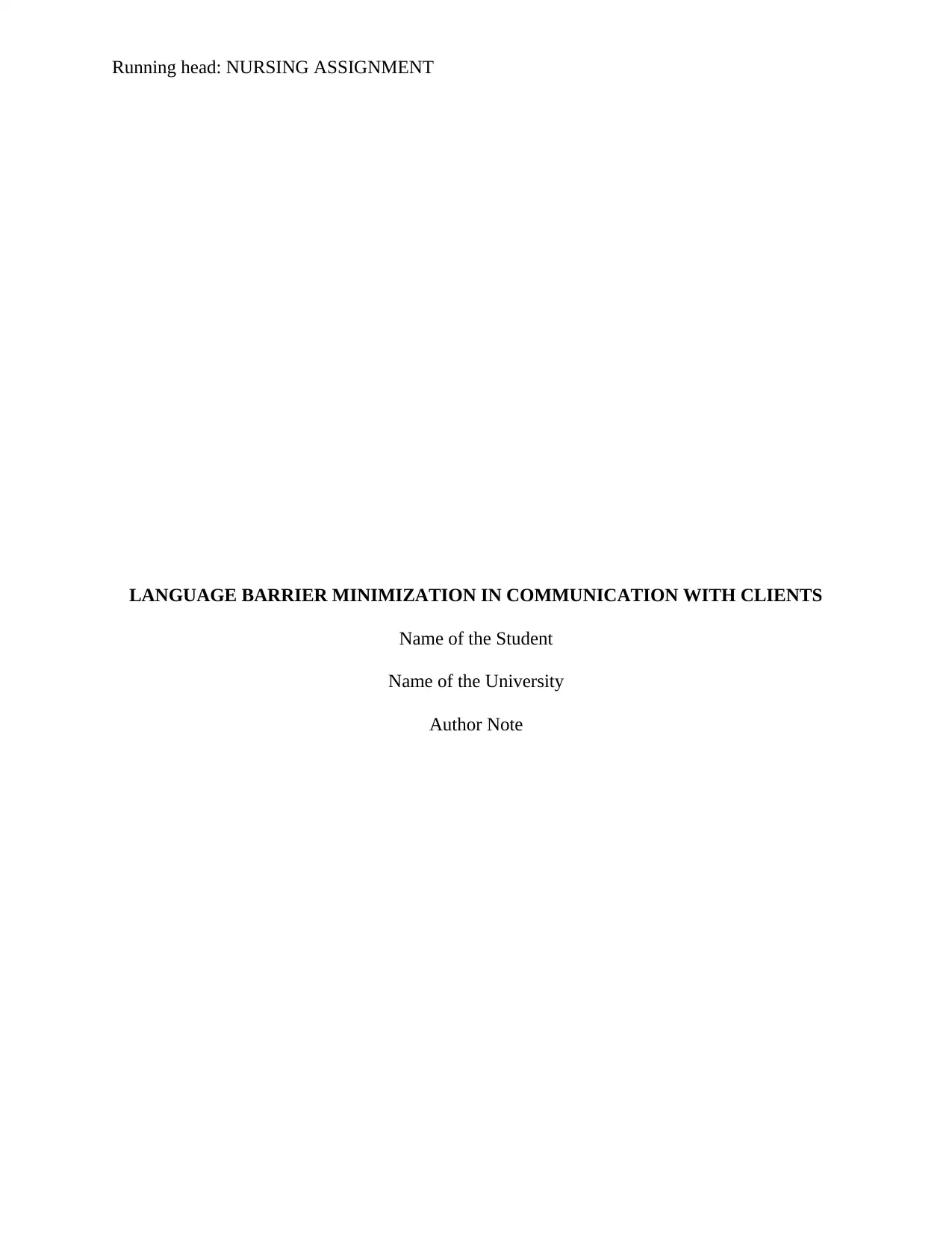
Running head: NURSING ASSIGNMENT
LANGUAGE BARRIER MINIMIZATION IN COMMUNICATION WITH CLIENTS
Name of the Student
Name of the University
Author Note
LANGUAGE BARRIER MINIMIZATION IN COMMUNICATION WITH CLIENTS
Name of the Student
Name of the University
Author Note
Paraphrase This Document
Need a fresh take? Get an instant paraphrase of this document with our AI Paraphraser
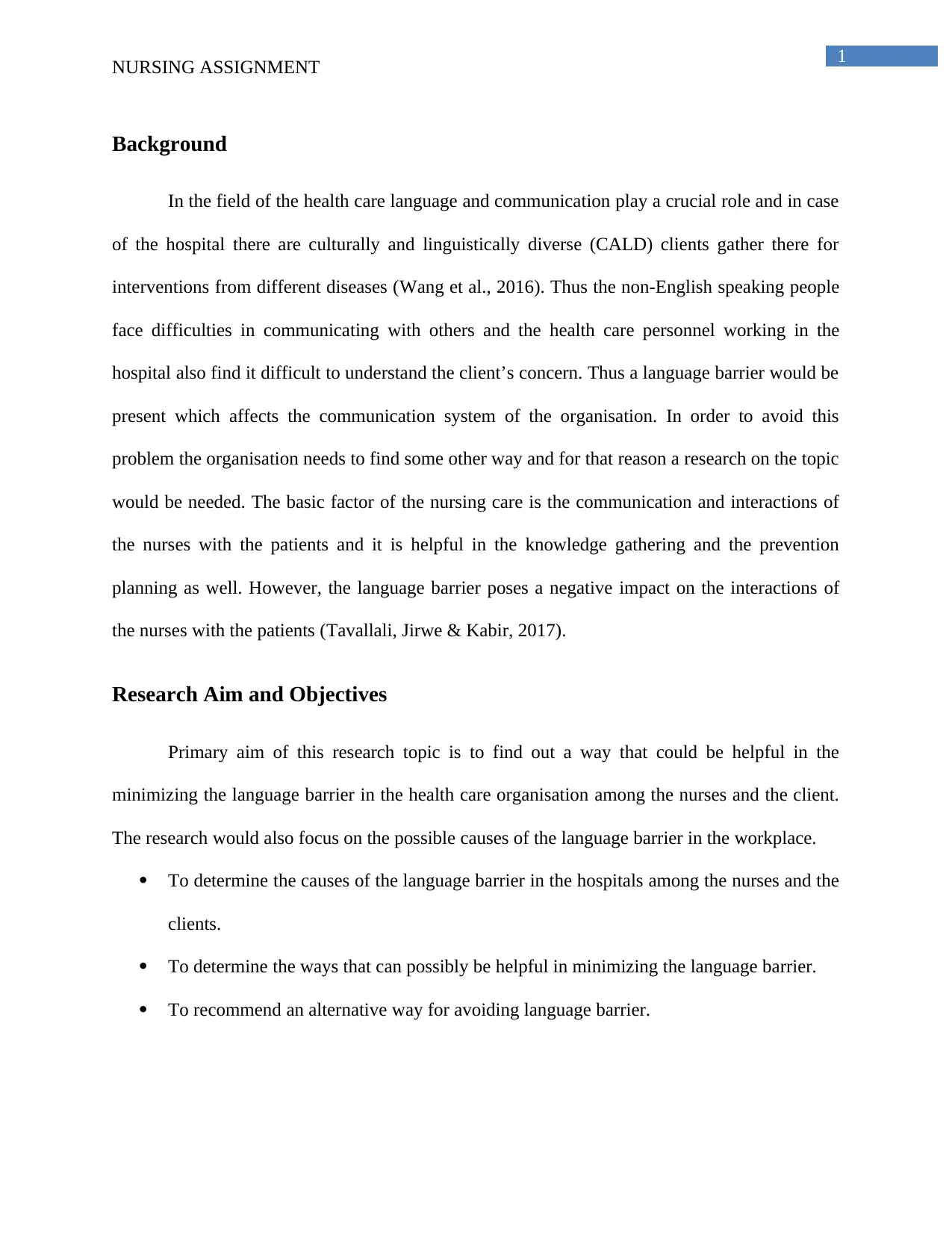
1
NURSING ASSIGNMENT
Background
In the field of the health care language and communication play a crucial role and in case
of the hospital there are culturally and linguistically diverse (CALD) clients gather there for
interventions from different diseases (Wang et al., 2016). Thus the non-English speaking people
face difficulties in communicating with others and the health care personnel working in the
hospital also find it difficult to understand the client’s concern. Thus a language barrier would be
present which affects the communication system of the organisation. In order to avoid this
problem the organisation needs to find some other way and for that reason a research on the topic
would be needed. The basic factor of the nursing care is the communication and interactions of
the nurses with the patients and it is helpful in the knowledge gathering and the prevention
planning as well. However, the language barrier poses a negative impact on the interactions of
the nurses with the patients (Tavallali, Jirwe & Kabir, 2017).
Research Aim and Objectives
Primary aim of this research topic is to find out a way that could be helpful in the
minimizing the language barrier in the health care organisation among the nurses and the client.
The research would also focus on the possible causes of the language barrier in the workplace.
To determine the causes of the language barrier in the hospitals among the nurses and the
clients.
To determine the ways that can possibly be helpful in minimizing the language barrier.
To recommend an alternative way for avoiding language barrier.
NURSING ASSIGNMENT
Background
In the field of the health care language and communication play a crucial role and in case
of the hospital there are culturally and linguistically diverse (CALD) clients gather there for
interventions from different diseases (Wang et al., 2016). Thus the non-English speaking people
face difficulties in communicating with others and the health care personnel working in the
hospital also find it difficult to understand the client’s concern. Thus a language barrier would be
present which affects the communication system of the organisation. In order to avoid this
problem the organisation needs to find some other way and for that reason a research on the topic
would be needed. The basic factor of the nursing care is the communication and interactions of
the nurses with the patients and it is helpful in the knowledge gathering and the prevention
planning as well. However, the language barrier poses a negative impact on the interactions of
the nurses with the patients (Tavallali, Jirwe & Kabir, 2017).
Research Aim and Objectives
Primary aim of this research topic is to find out a way that could be helpful in the
minimizing the language barrier in the health care organisation among the nurses and the client.
The research would also focus on the possible causes of the language barrier in the workplace.
To determine the causes of the language barrier in the hospitals among the nurses and the
clients.
To determine the ways that can possibly be helpful in minimizing the language barrier.
To recommend an alternative way for avoiding language barrier.
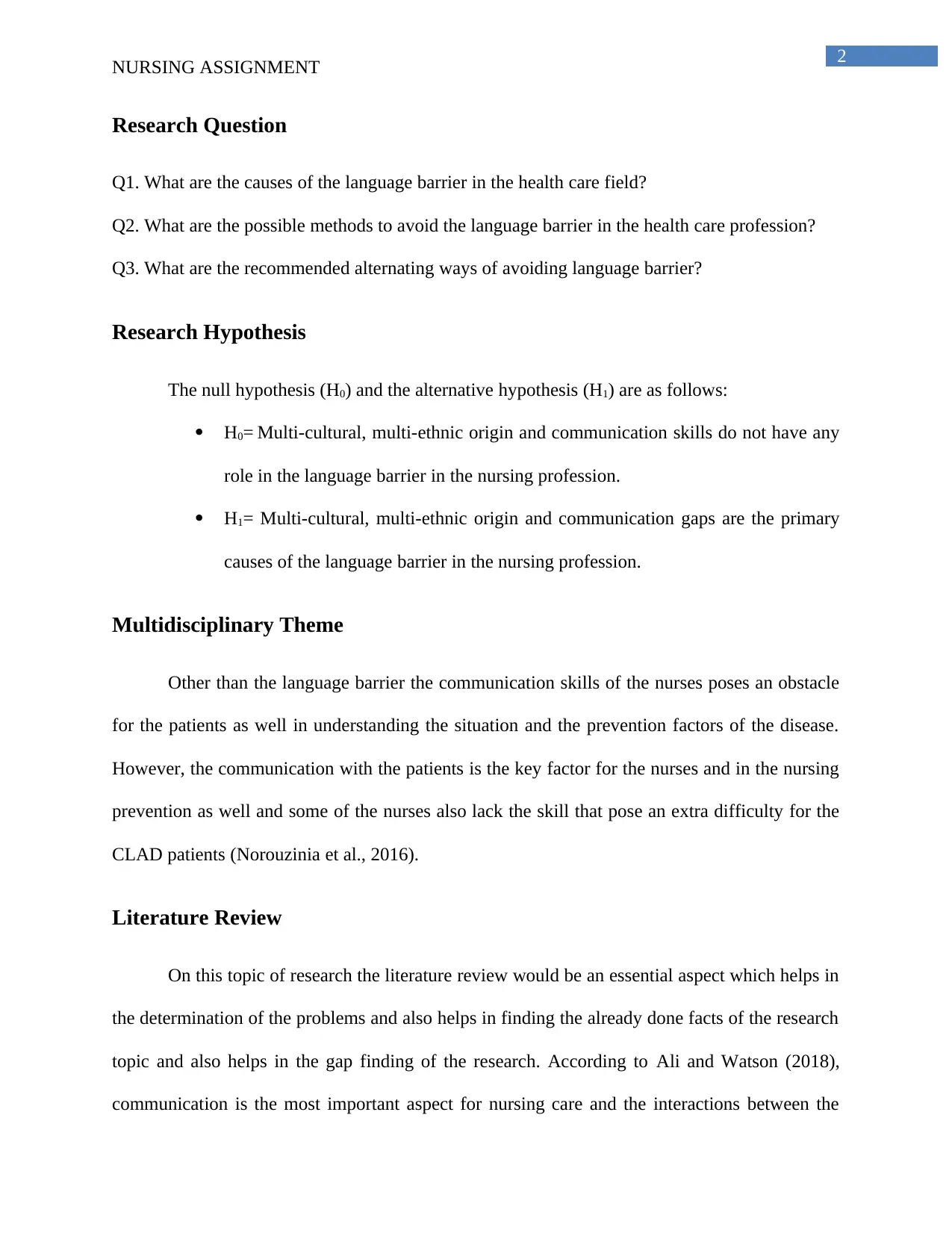
2
NURSING ASSIGNMENT
Research Question
Q1. What are the causes of the language barrier in the health care field?
Q2. What are the possible methods to avoid the language barrier in the health care profession?
Q3. What are the recommended alternating ways of avoiding language barrier?
Research Hypothesis
The null hypothesis (H0) and the alternative hypothesis (H1) are as follows:
H0= Multi-cultural, multi-ethnic origin and communication skills do not have any
role in the language barrier in the nursing profession.
H1= Multi-cultural, multi-ethnic origin and communication gaps are the primary
causes of the language barrier in the nursing profession.
Multidisciplinary Theme
Other than the language barrier the communication skills of the nurses poses an obstacle
for the patients as well in understanding the situation and the prevention factors of the disease.
However, the communication with the patients is the key factor for the nurses and in the nursing
prevention as well and some of the nurses also lack the skill that pose an extra difficulty for the
CLAD patients (Norouzinia et al., 2016).
Literature Review
On this topic of research the literature review would be an essential aspect which helps in
the determination of the problems and also helps in finding the already done facts of the research
topic and also helps in the gap finding of the research. According to Ali and Watson (2018),
communication is the most important aspect for nursing care and the interactions between the
NURSING ASSIGNMENT
Research Question
Q1. What are the causes of the language barrier in the health care field?
Q2. What are the possible methods to avoid the language barrier in the health care profession?
Q3. What are the recommended alternating ways of avoiding language barrier?
Research Hypothesis
The null hypothesis (H0) and the alternative hypothesis (H1) are as follows:
H0= Multi-cultural, multi-ethnic origin and communication skills do not have any
role in the language barrier in the nursing profession.
H1= Multi-cultural, multi-ethnic origin and communication gaps are the primary
causes of the language barrier in the nursing profession.
Multidisciplinary Theme
Other than the language barrier the communication skills of the nurses poses an obstacle
for the patients as well in understanding the situation and the prevention factors of the disease.
However, the communication with the patients is the key factor for the nurses and in the nursing
prevention as well and some of the nurses also lack the skill that pose an extra difficulty for the
CLAD patients (Norouzinia et al., 2016).
Literature Review
On this topic of research the literature review would be an essential aspect which helps in
the determination of the problems and also helps in finding the already done facts of the research
topic and also helps in the gap finding of the research. According to Ali and Watson (2018),
communication is the most important aspect for nursing care and the interactions between the
⊘ This is a preview!⊘
Do you want full access?
Subscribe today to unlock all pages.

Trusted by 1+ million students worldwide
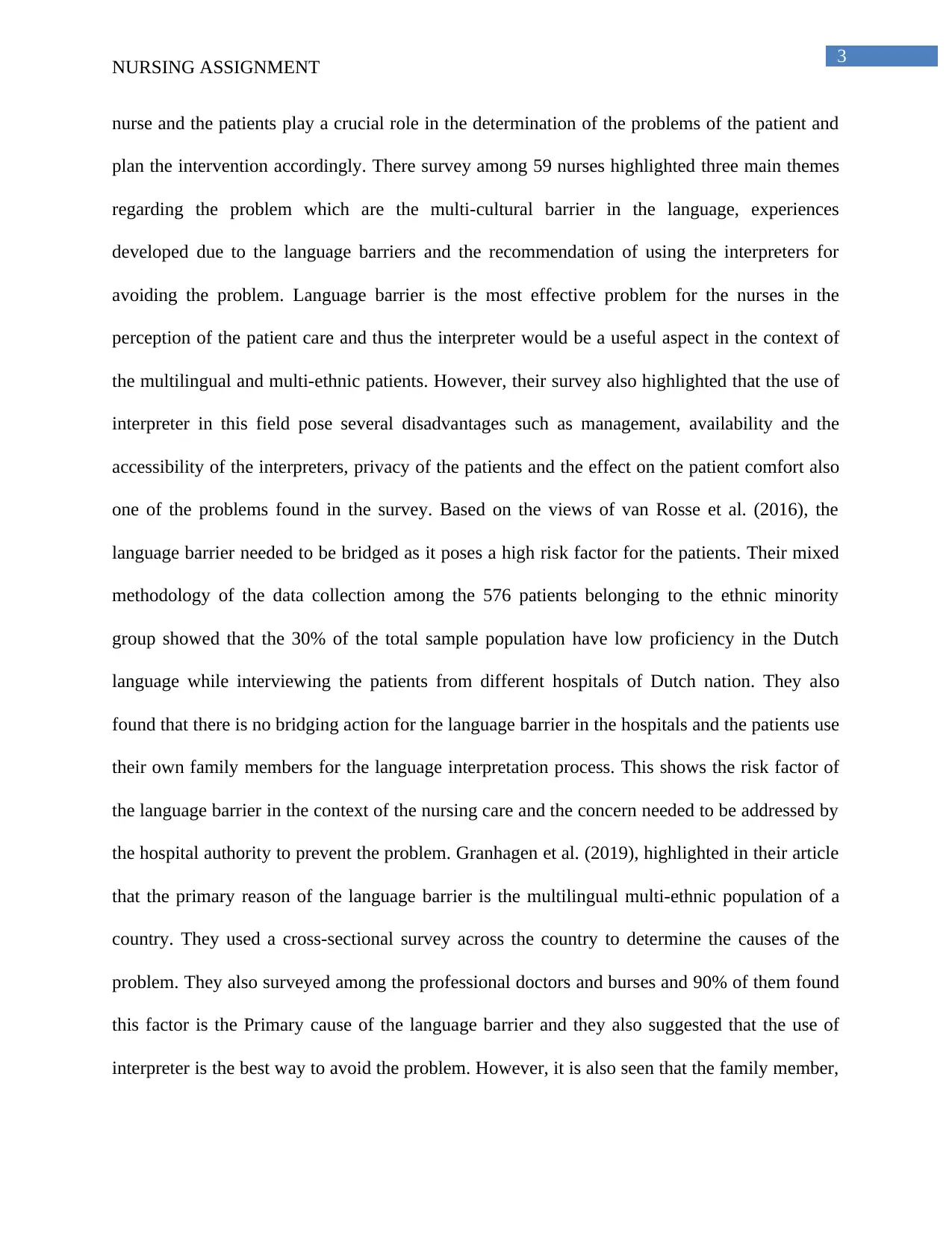
3
NURSING ASSIGNMENT
nurse and the patients play a crucial role in the determination of the problems of the patient and
plan the intervention accordingly. There survey among 59 nurses highlighted three main themes
regarding the problem which are the multi-cultural barrier in the language, experiences
developed due to the language barriers and the recommendation of using the interpreters for
avoiding the problem. Language barrier is the most effective problem for the nurses in the
perception of the patient care and thus the interpreter would be a useful aspect in the context of
the multilingual and multi-ethnic patients. However, their survey also highlighted that the use of
interpreter in this field pose several disadvantages such as management, availability and the
accessibility of the interpreters, privacy of the patients and the effect on the patient comfort also
one of the problems found in the survey. Based on the views of van Rosse et al. (2016), the
language barrier needed to be bridged as it poses a high risk factor for the patients. Their mixed
methodology of the data collection among the 576 patients belonging to the ethnic minority
group showed that the 30% of the total sample population have low proficiency in the Dutch
language while interviewing the patients from different hospitals of Dutch nation. They also
found that there is no bridging action for the language barrier in the hospitals and the patients use
their own family members for the language interpretation process. This shows the risk factor of
the language barrier in the context of the nursing care and the concern needed to be addressed by
the hospital authority to prevent the problem. Granhagen et al. (2019), highlighted in their article
that the primary reason of the language barrier is the multilingual multi-ethnic population of a
country. They used a cross-sectional survey across the country to determine the causes of the
problem. They also surveyed among the professional doctors and burses and 90% of them found
this factor is the Primary cause of the language barrier and they also suggested that the use of
interpreter is the best way to avoid the problem. However, it is also seen that the family member,
NURSING ASSIGNMENT
nurse and the patients play a crucial role in the determination of the problems of the patient and
plan the intervention accordingly. There survey among 59 nurses highlighted three main themes
regarding the problem which are the multi-cultural barrier in the language, experiences
developed due to the language barriers and the recommendation of using the interpreters for
avoiding the problem. Language barrier is the most effective problem for the nurses in the
perception of the patient care and thus the interpreter would be a useful aspect in the context of
the multilingual and multi-ethnic patients. However, their survey also highlighted that the use of
interpreter in this field pose several disadvantages such as management, availability and the
accessibility of the interpreters, privacy of the patients and the effect on the patient comfort also
one of the problems found in the survey. Based on the views of van Rosse et al. (2016), the
language barrier needed to be bridged as it poses a high risk factor for the patients. Their mixed
methodology of the data collection among the 576 patients belonging to the ethnic minority
group showed that the 30% of the total sample population have low proficiency in the Dutch
language while interviewing the patients from different hospitals of Dutch nation. They also
found that there is no bridging action for the language barrier in the hospitals and the patients use
their own family members for the language interpretation process. This shows the risk factor of
the language barrier in the context of the nursing care and the concern needed to be addressed by
the hospital authority to prevent the problem. Granhagen et al. (2019), highlighted in their article
that the primary reason of the language barrier is the multilingual multi-ethnic population of a
country. They used a cross-sectional survey across the country to determine the causes of the
problem. They also surveyed among the professional doctors and burses and 90% of them found
this factor is the Primary cause of the language barrier and they also suggested that the use of
interpreter is the best way to avoid the problem. However, it is also seen that the family member,
Paraphrase This Document
Need a fresh take? Get an instant paraphrase of this document with our AI Paraphraser
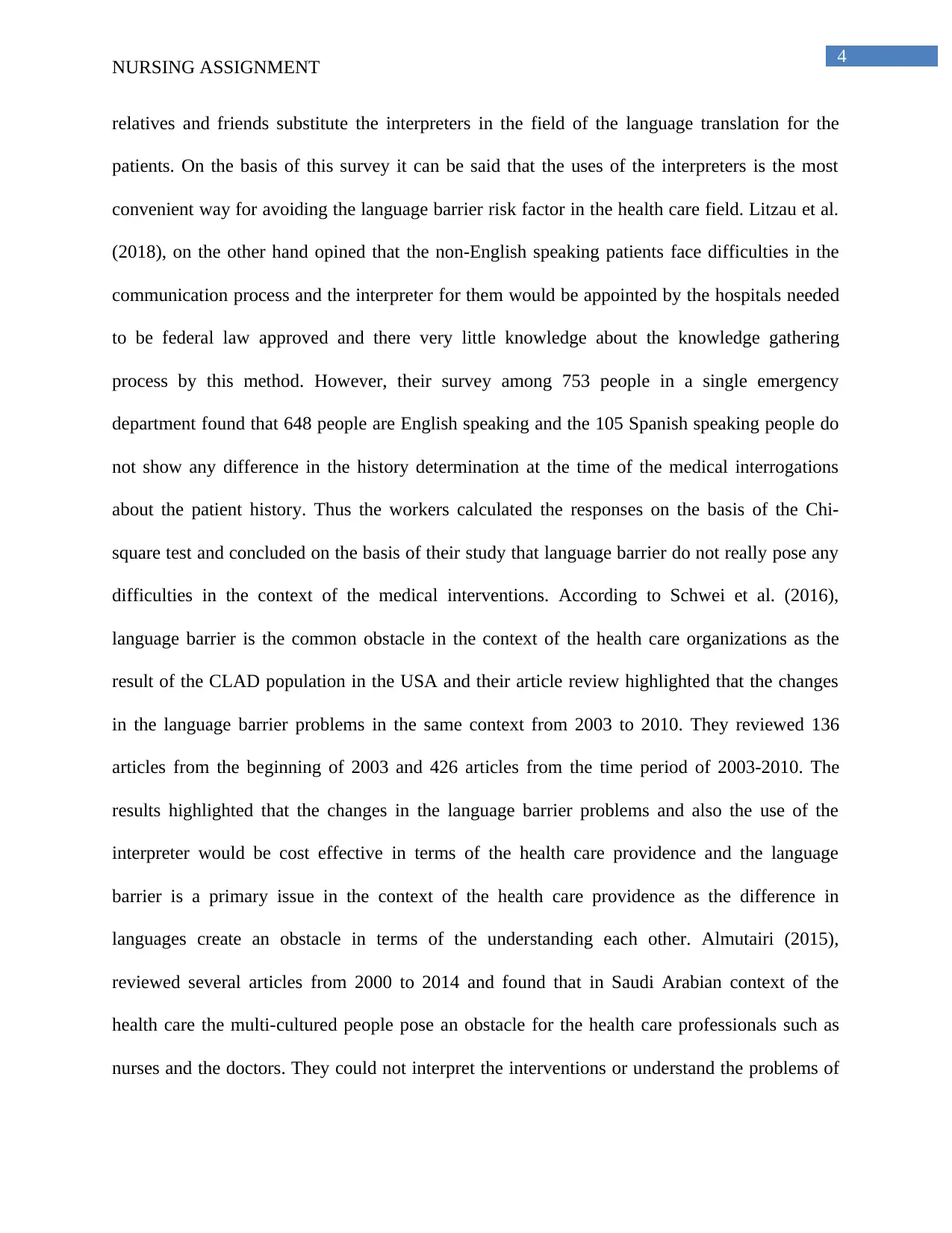
4
NURSING ASSIGNMENT
relatives and friends substitute the interpreters in the field of the language translation for the
patients. On the basis of this survey it can be said that the uses of the interpreters is the most
convenient way for avoiding the language barrier risk factor in the health care field. Litzau et al.
(2018), on the other hand opined that the non-English speaking patients face difficulties in the
communication process and the interpreter for them would be appointed by the hospitals needed
to be federal law approved and there very little knowledge about the knowledge gathering
process by this method. However, their survey among 753 people in a single emergency
department found that 648 people are English speaking and the 105 Spanish speaking people do
not show any difference in the history determination at the time of the medical interrogations
about the patient history. Thus the workers calculated the responses on the basis of the Chi-
square test and concluded on the basis of their study that language barrier do not really pose any
difficulties in the context of the medical interventions. According to Schwei et al. (2016),
language barrier is the common obstacle in the context of the health care organizations as the
result of the CLAD population in the USA and their article review highlighted that the changes
in the language barrier problems in the same context from 2003 to 2010. They reviewed 136
articles from the beginning of 2003 and 426 articles from the time period of 2003-2010. The
results highlighted that the changes in the language barrier problems and also the use of the
interpreter would be cost effective in terms of the health care providence and the language
barrier is a primary issue in the context of the health care providence as the difference in
languages create an obstacle in terms of the understanding each other. Almutairi (2015),
reviewed several articles from 2000 to 2014 and found that in Saudi Arabian context of the
health care the multi-cultured people pose an obstacle for the health care professionals such as
nurses and the doctors. They could not interpret the interventions or understand the problems of
NURSING ASSIGNMENT
relatives and friends substitute the interpreters in the field of the language translation for the
patients. On the basis of this survey it can be said that the uses of the interpreters is the most
convenient way for avoiding the language barrier risk factor in the health care field. Litzau et al.
(2018), on the other hand opined that the non-English speaking patients face difficulties in the
communication process and the interpreter for them would be appointed by the hospitals needed
to be federal law approved and there very little knowledge about the knowledge gathering
process by this method. However, their survey among 753 people in a single emergency
department found that 648 people are English speaking and the 105 Spanish speaking people do
not show any difference in the history determination at the time of the medical interrogations
about the patient history. Thus the workers calculated the responses on the basis of the Chi-
square test and concluded on the basis of their study that language barrier do not really pose any
difficulties in the context of the medical interventions. According to Schwei et al. (2016),
language barrier is the common obstacle in the context of the health care organizations as the
result of the CLAD population in the USA and their article review highlighted that the changes
in the language barrier problems in the same context from 2003 to 2010. They reviewed 136
articles from the beginning of 2003 and 426 articles from the time period of 2003-2010. The
results highlighted that the changes in the language barrier problems and also the use of the
interpreter would be cost effective in terms of the health care providence and the language
barrier is a primary issue in the context of the health care providence as the difference in
languages create an obstacle in terms of the understanding each other. Almutairi (2015),
reviewed several articles from 2000 to 2014 and found that in Saudi Arabian context of the
health care the multi-cultured people pose an obstacle for the health care professionals such as
nurses and the doctors. They could not interpret the interventions or understand the problems of
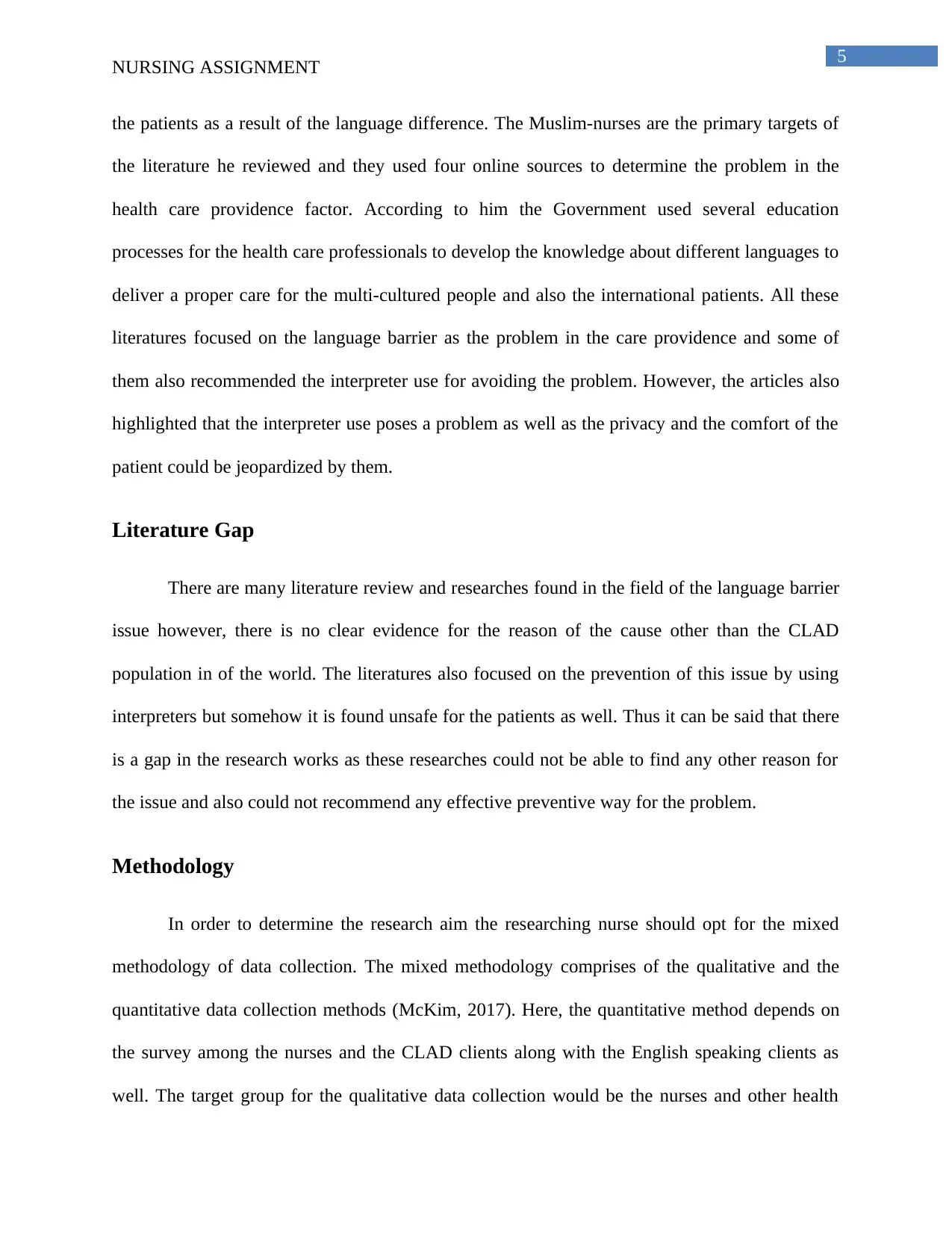
5
NURSING ASSIGNMENT
the patients as a result of the language difference. The Muslim-nurses are the primary targets of
the literature he reviewed and they used four online sources to determine the problem in the
health care providence factor. According to him the Government used several education
processes for the health care professionals to develop the knowledge about different languages to
deliver a proper care for the multi-cultured people and also the international patients. All these
literatures focused on the language barrier as the problem in the care providence and some of
them also recommended the interpreter use for avoiding the problem. However, the articles also
highlighted that the interpreter use poses a problem as well as the privacy and the comfort of the
patient could be jeopardized by them.
Literature Gap
There are many literature review and researches found in the field of the language barrier
issue however, there is no clear evidence for the reason of the cause other than the CLAD
population in of the world. The literatures also focused on the prevention of this issue by using
interpreters but somehow it is found unsafe for the patients as well. Thus it can be said that there
is a gap in the research works as these researches could not be able to find any other reason for
the issue and also could not recommend any effective preventive way for the problem.
Methodology
In order to determine the research aim the researching nurse should opt for the mixed
methodology of data collection. The mixed methodology comprises of the qualitative and the
quantitative data collection methods (McKim, 2017). Here, the quantitative method depends on
the survey among the nurses and the CLAD clients along with the English speaking clients as
well. The target group for the qualitative data collection would be the nurses and other health
NURSING ASSIGNMENT
the patients as a result of the language difference. The Muslim-nurses are the primary targets of
the literature he reviewed and they used four online sources to determine the problem in the
health care providence factor. According to him the Government used several education
processes for the health care professionals to develop the knowledge about different languages to
deliver a proper care for the multi-cultured people and also the international patients. All these
literatures focused on the language barrier as the problem in the care providence and some of
them also recommended the interpreter use for avoiding the problem. However, the articles also
highlighted that the interpreter use poses a problem as well as the privacy and the comfort of the
patient could be jeopardized by them.
Literature Gap
There are many literature review and researches found in the field of the language barrier
issue however, there is no clear evidence for the reason of the cause other than the CLAD
population in of the world. The literatures also focused on the prevention of this issue by using
interpreters but somehow it is found unsafe for the patients as well. Thus it can be said that there
is a gap in the research works as these researches could not be able to find any other reason for
the issue and also could not recommend any effective preventive way for the problem.
Methodology
In order to determine the research aim the researching nurse should opt for the mixed
methodology of data collection. The mixed methodology comprises of the qualitative and the
quantitative data collection methods (McKim, 2017). Here, the quantitative method depends on
the survey among the nurses and the CLAD clients along with the English speaking clients as
well. The target group for the qualitative data collection would be the nurses and other health
⊘ This is a preview!⊘
Do you want full access?
Subscribe today to unlock all pages.

Trusted by 1+ million students worldwide
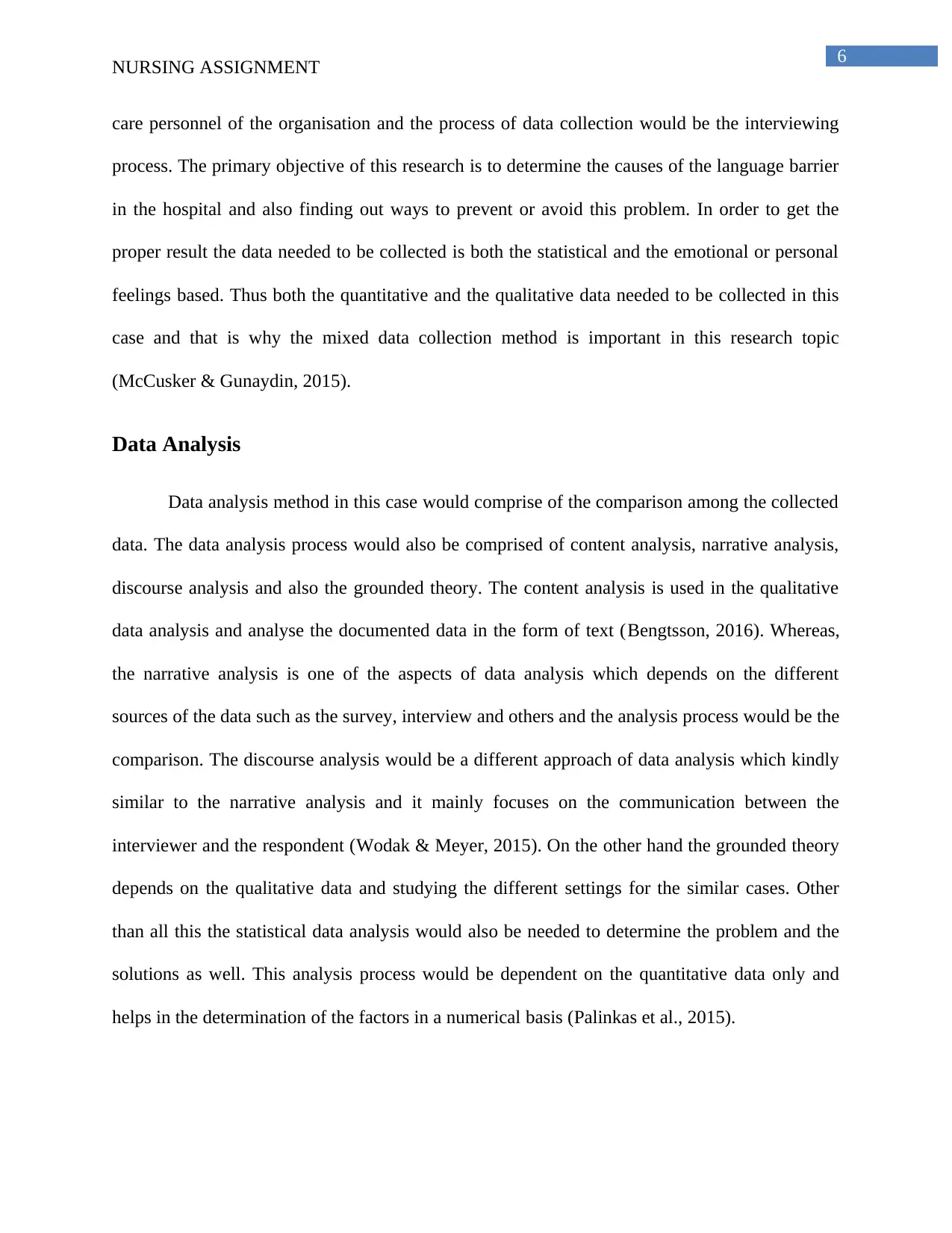
6
NURSING ASSIGNMENT
care personnel of the organisation and the process of data collection would be the interviewing
process. The primary objective of this research is to determine the causes of the language barrier
in the hospital and also finding out ways to prevent or avoid this problem. In order to get the
proper result the data needed to be collected is both the statistical and the emotional or personal
feelings based. Thus both the quantitative and the qualitative data needed to be collected in this
case and that is why the mixed data collection method is important in this research topic
(McCusker & Gunaydin, 2015).
Data Analysis
Data analysis method in this case would comprise of the comparison among the collected
data. The data analysis process would also be comprised of content analysis, narrative analysis,
discourse analysis and also the grounded theory. The content analysis is used in the qualitative
data analysis and analyse the documented data in the form of text (Bengtsson, 2016). Whereas,
the narrative analysis is one of the aspects of data analysis which depends on the different
sources of the data such as the survey, interview and others and the analysis process would be the
comparison. The discourse analysis would be a different approach of data analysis which kindly
similar to the narrative analysis and it mainly focuses on the communication between the
interviewer and the respondent (Wodak & Meyer, 2015). On the other hand the grounded theory
depends on the qualitative data and studying the different settings for the similar cases. Other
than all this the statistical data analysis would also be needed to determine the problem and the
solutions as well. This analysis process would be dependent on the quantitative data only and
helps in the determination of the factors in a numerical basis (Palinkas et al., 2015).
NURSING ASSIGNMENT
care personnel of the organisation and the process of data collection would be the interviewing
process. The primary objective of this research is to determine the causes of the language barrier
in the hospital and also finding out ways to prevent or avoid this problem. In order to get the
proper result the data needed to be collected is both the statistical and the emotional or personal
feelings based. Thus both the quantitative and the qualitative data needed to be collected in this
case and that is why the mixed data collection method is important in this research topic
(McCusker & Gunaydin, 2015).
Data Analysis
Data analysis method in this case would comprise of the comparison among the collected
data. The data analysis process would also be comprised of content analysis, narrative analysis,
discourse analysis and also the grounded theory. The content analysis is used in the qualitative
data analysis and analyse the documented data in the form of text (Bengtsson, 2016). Whereas,
the narrative analysis is one of the aspects of data analysis which depends on the different
sources of the data such as the survey, interview and others and the analysis process would be the
comparison. The discourse analysis would be a different approach of data analysis which kindly
similar to the narrative analysis and it mainly focuses on the communication between the
interviewer and the respondent (Wodak & Meyer, 2015). On the other hand the grounded theory
depends on the qualitative data and studying the different settings for the similar cases. Other
than all this the statistical data analysis would also be needed to determine the problem and the
solutions as well. This analysis process would be dependent on the quantitative data only and
helps in the determination of the factors in a numerical basis (Palinkas et al., 2015).
Paraphrase This Document
Need a fresh take? Get an instant paraphrase of this document with our AI Paraphraser
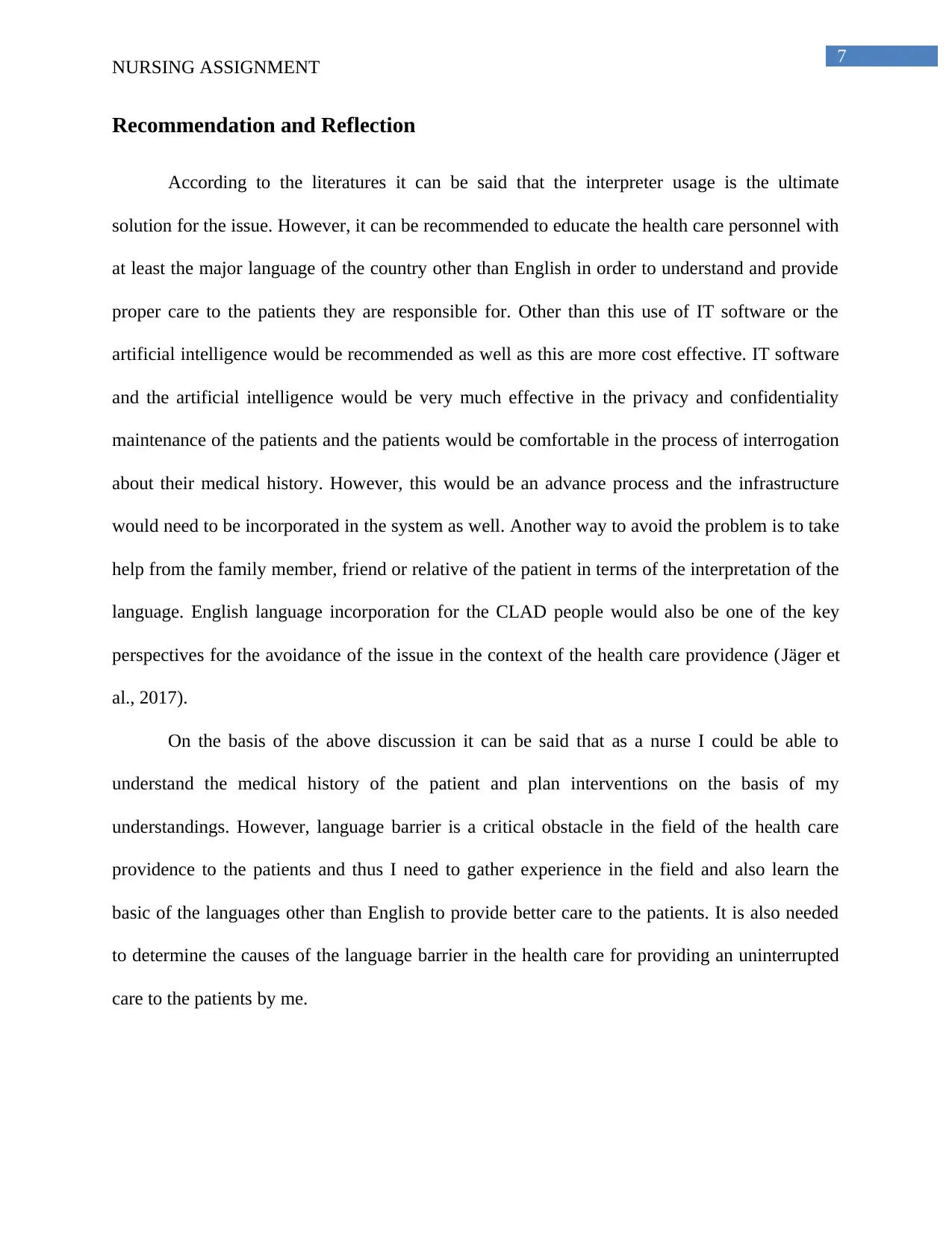
7
NURSING ASSIGNMENT
Recommendation and Reflection
According to the literatures it can be said that the interpreter usage is the ultimate
solution for the issue. However, it can be recommended to educate the health care personnel with
at least the major language of the country other than English in order to understand and provide
proper care to the patients they are responsible for. Other than this use of IT software or the
artificial intelligence would be recommended as well as this are more cost effective. IT software
and the artificial intelligence would be very much effective in the privacy and confidentiality
maintenance of the patients and the patients would be comfortable in the process of interrogation
about their medical history. However, this would be an advance process and the infrastructure
would need to be incorporated in the system as well. Another way to avoid the problem is to take
help from the family member, friend or relative of the patient in terms of the interpretation of the
language. English language incorporation for the CLAD people would also be one of the key
perspectives for the avoidance of the issue in the context of the health care providence (Jäger et
al., 2017).
On the basis of the above discussion it can be said that as a nurse I could be able to
understand the medical history of the patient and plan interventions on the basis of my
understandings. However, language barrier is a critical obstacle in the field of the health care
providence to the patients and thus I need to gather experience in the field and also learn the
basic of the languages other than English to provide better care to the patients. It is also needed
to determine the causes of the language barrier in the health care for providing an uninterrupted
care to the patients by me.
NURSING ASSIGNMENT
Recommendation and Reflection
According to the literatures it can be said that the interpreter usage is the ultimate
solution for the issue. However, it can be recommended to educate the health care personnel with
at least the major language of the country other than English in order to understand and provide
proper care to the patients they are responsible for. Other than this use of IT software or the
artificial intelligence would be recommended as well as this are more cost effective. IT software
and the artificial intelligence would be very much effective in the privacy and confidentiality
maintenance of the patients and the patients would be comfortable in the process of interrogation
about their medical history. However, this would be an advance process and the infrastructure
would need to be incorporated in the system as well. Another way to avoid the problem is to take
help from the family member, friend or relative of the patient in terms of the interpretation of the
language. English language incorporation for the CLAD people would also be one of the key
perspectives for the avoidance of the issue in the context of the health care providence (Jäger et
al., 2017).
On the basis of the above discussion it can be said that as a nurse I could be able to
understand the medical history of the patient and plan interventions on the basis of my
understandings. However, language barrier is a critical obstacle in the field of the health care
providence to the patients and thus I need to gather experience in the field and also learn the
basic of the languages other than English to provide better care to the patients. It is also needed
to determine the causes of the language barrier in the health care for providing an uninterrupted
care to the patients by me.
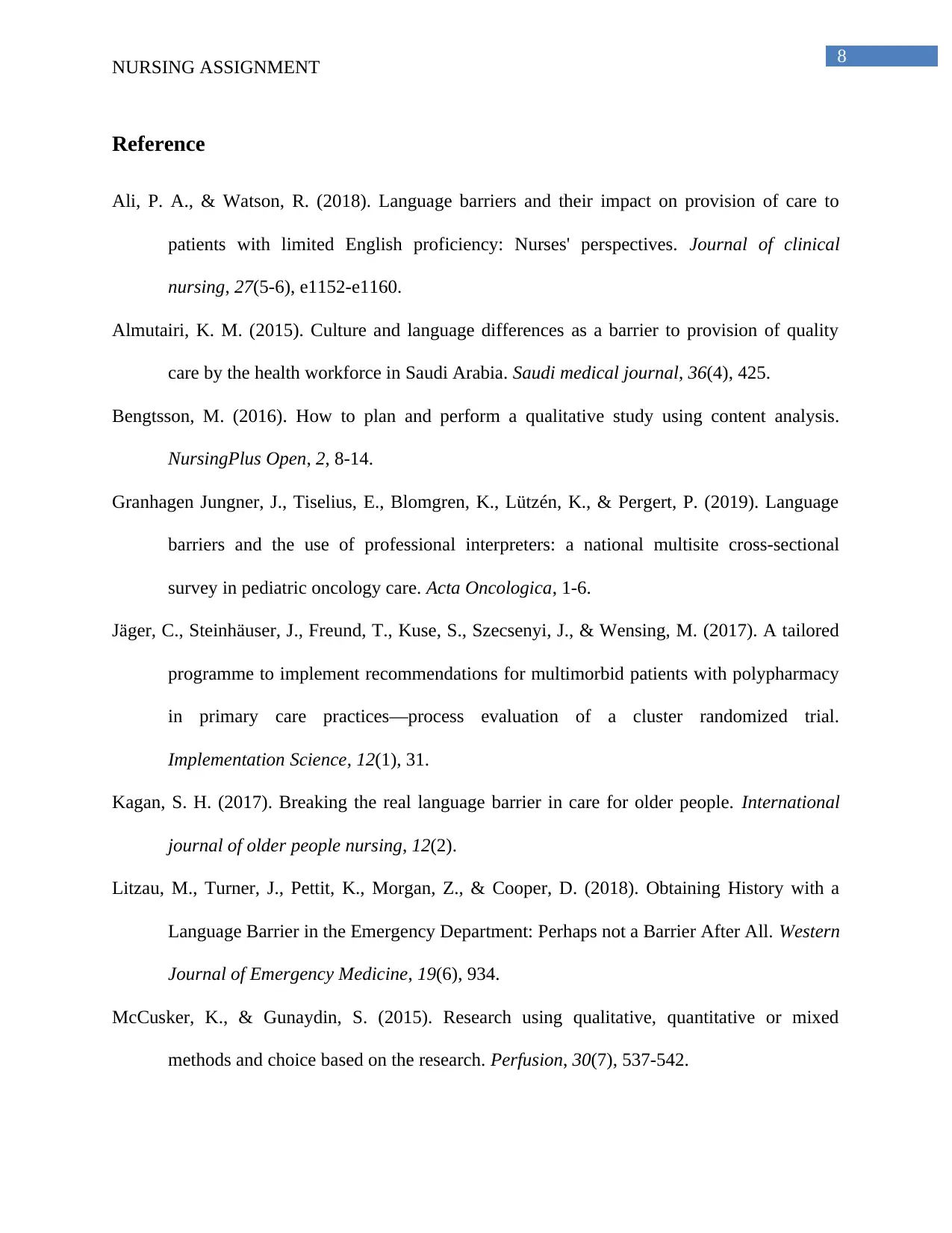
8
NURSING ASSIGNMENT
Reference
Ali, P. A., & Watson, R. (2018). Language barriers and their impact on provision of care to
patients with limited English proficiency: Nurses' perspectives. Journal of clinical
nursing, 27(5-6), e1152-e1160.
Almutairi, K. M. (2015). Culture and language differences as a barrier to provision of quality
care by the health workforce in Saudi Arabia. Saudi medical journal, 36(4), 425.
Bengtsson, M. (2016). How to plan and perform a qualitative study using content analysis.
NursingPlus Open, 2, 8-14.
Granhagen Jungner, J., Tiselius, E., Blomgren, K., Lützén, K., & Pergert, P. (2019). Language
barriers and the use of professional interpreters: a national multisite cross-sectional
survey in pediatric oncology care. Acta Oncologica, 1-6.
Jäger, C., Steinhäuser, J., Freund, T., Kuse, S., Szecsenyi, J., & Wensing, M. (2017). A tailored
programme to implement recommendations for multimorbid patients with polypharmacy
in primary care practices—process evaluation of a cluster randomized trial.
Implementation Science, 12(1), 31.
Kagan, S. H. (2017). Breaking the real language barrier in care for older people. International
journal of older people nursing, 12(2).
Litzau, M., Turner, J., Pettit, K., Morgan, Z., & Cooper, D. (2018). Obtaining History with a
Language Barrier in the Emergency Department: Perhaps not a Barrier After All. Western
Journal of Emergency Medicine, 19(6), 934.
McCusker, K., & Gunaydin, S. (2015). Research using qualitative, quantitative or mixed
methods and choice based on the research. Perfusion, 30(7), 537-542.
NURSING ASSIGNMENT
Reference
Ali, P. A., & Watson, R. (2018). Language barriers and their impact on provision of care to
patients with limited English proficiency: Nurses' perspectives. Journal of clinical
nursing, 27(5-6), e1152-e1160.
Almutairi, K. M. (2015). Culture and language differences as a barrier to provision of quality
care by the health workforce in Saudi Arabia. Saudi medical journal, 36(4), 425.
Bengtsson, M. (2016). How to plan and perform a qualitative study using content analysis.
NursingPlus Open, 2, 8-14.
Granhagen Jungner, J., Tiselius, E., Blomgren, K., Lützén, K., & Pergert, P. (2019). Language
barriers and the use of professional interpreters: a national multisite cross-sectional
survey in pediatric oncology care. Acta Oncologica, 1-6.
Jäger, C., Steinhäuser, J., Freund, T., Kuse, S., Szecsenyi, J., & Wensing, M. (2017). A tailored
programme to implement recommendations for multimorbid patients with polypharmacy
in primary care practices—process evaluation of a cluster randomized trial.
Implementation Science, 12(1), 31.
Kagan, S. H. (2017). Breaking the real language barrier in care for older people. International
journal of older people nursing, 12(2).
Litzau, M., Turner, J., Pettit, K., Morgan, Z., & Cooper, D. (2018). Obtaining History with a
Language Barrier in the Emergency Department: Perhaps not a Barrier After All. Western
Journal of Emergency Medicine, 19(6), 934.
McCusker, K., & Gunaydin, S. (2015). Research using qualitative, quantitative or mixed
methods and choice based on the research. Perfusion, 30(7), 537-542.
⊘ This is a preview!⊘
Do you want full access?
Subscribe today to unlock all pages.

Trusted by 1+ million students worldwide
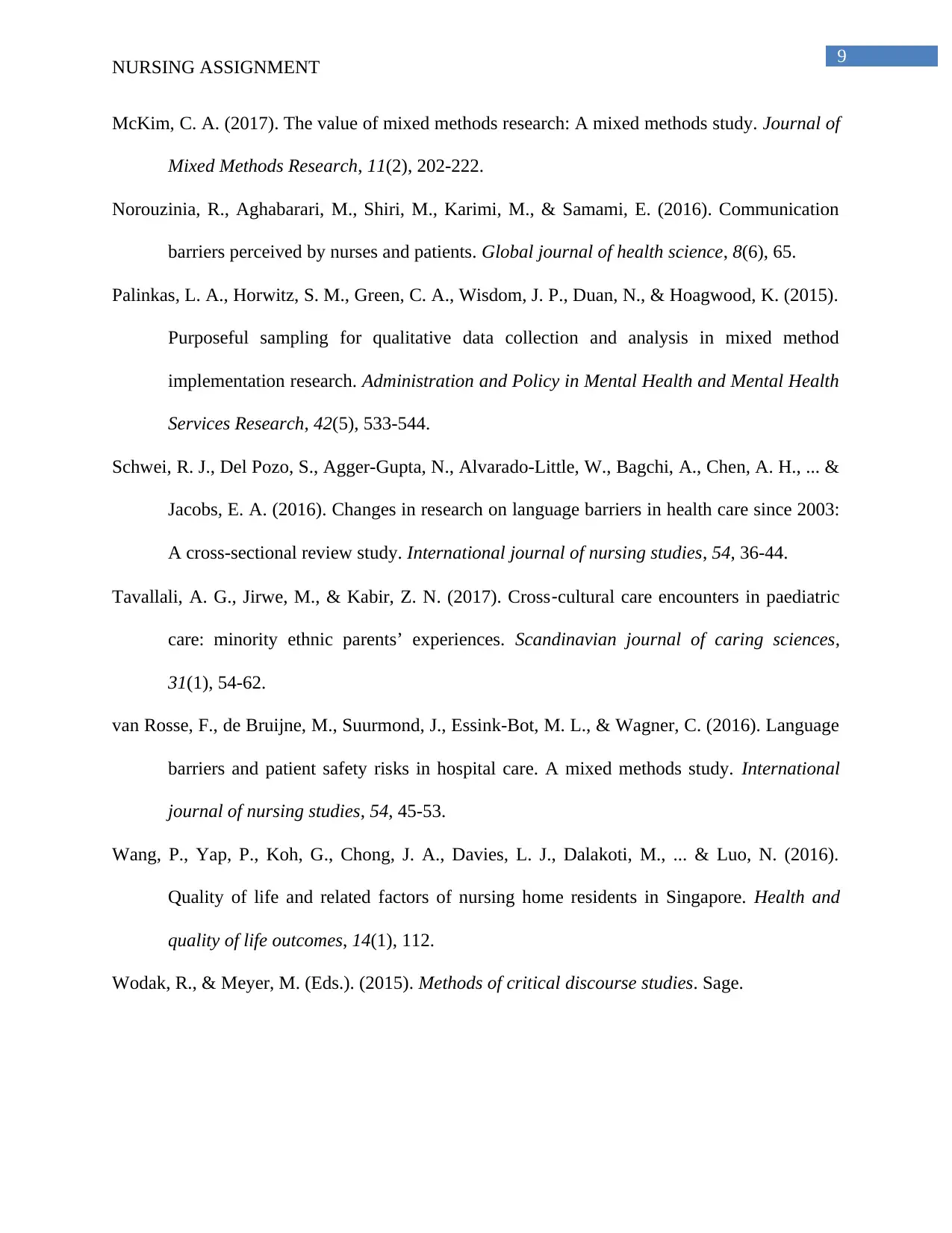
9
NURSING ASSIGNMENT
McKim, C. A. (2017). The value of mixed methods research: A mixed methods study. Journal of
Mixed Methods Research, 11(2), 202-222.
Norouzinia, R., Aghabarari, M., Shiri, M., Karimi, M., & Samami, E. (2016). Communication
barriers perceived by nurses and patients. Global journal of health science, 8(6), 65.
Palinkas, L. A., Horwitz, S. M., Green, C. A., Wisdom, J. P., Duan, N., & Hoagwood, K. (2015).
Purposeful sampling for qualitative data collection and analysis in mixed method
implementation research. Administration and Policy in Mental Health and Mental Health
Services Research, 42(5), 533-544.
Schwei, R. J., Del Pozo, S., Agger-Gupta, N., Alvarado-Little, W., Bagchi, A., Chen, A. H., ... &
Jacobs, E. A. (2016). Changes in research on language barriers in health care since 2003:
A cross-sectional review study. International journal of nursing studies, 54, 36-44.
Tavallali, A. G., Jirwe, M., & Kabir, Z. N. (2017). Cross‐cultural care encounters in paediatric
care: minority ethnic parents’ experiences. Scandinavian journal of caring sciences,
31(1), 54-62.
van Rosse, F., de Bruijne, M., Suurmond, J., Essink-Bot, M. L., & Wagner, C. (2016). Language
barriers and patient safety risks in hospital care. A mixed methods study. International
journal of nursing studies, 54, 45-53.
Wang, P., Yap, P., Koh, G., Chong, J. A., Davies, L. J., Dalakoti, M., ... & Luo, N. (2016).
Quality of life and related factors of nursing home residents in Singapore. Health and
quality of life outcomes, 14(1), 112.
Wodak, R., & Meyer, M. (Eds.). (2015). Methods of critical discourse studies. Sage.
NURSING ASSIGNMENT
McKim, C. A. (2017). The value of mixed methods research: A mixed methods study. Journal of
Mixed Methods Research, 11(2), 202-222.
Norouzinia, R., Aghabarari, M., Shiri, M., Karimi, M., & Samami, E. (2016). Communication
barriers perceived by nurses and patients. Global journal of health science, 8(6), 65.
Palinkas, L. A., Horwitz, S. M., Green, C. A., Wisdom, J. P., Duan, N., & Hoagwood, K. (2015).
Purposeful sampling for qualitative data collection and analysis in mixed method
implementation research. Administration and Policy in Mental Health and Mental Health
Services Research, 42(5), 533-544.
Schwei, R. J., Del Pozo, S., Agger-Gupta, N., Alvarado-Little, W., Bagchi, A., Chen, A. H., ... &
Jacobs, E. A. (2016). Changes in research on language barriers in health care since 2003:
A cross-sectional review study. International journal of nursing studies, 54, 36-44.
Tavallali, A. G., Jirwe, M., & Kabir, Z. N. (2017). Cross‐cultural care encounters in paediatric
care: minority ethnic parents’ experiences. Scandinavian journal of caring sciences,
31(1), 54-62.
van Rosse, F., de Bruijne, M., Suurmond, J., Essink-Bot, M. L., & Wagner, C. (2016). Language
barriers and patient safety risks in hospital care. A mixed methods study. International
journal of nursing studies, 54, 45-53.
Wang, P., Yap, P., Koh, G., Chong, J. A., Davies, L. J., Dalakoti, M., ... & Luo, N. (2016).
Quality of life and related factors of nursing home residents in Singapore. Health and
quality of life outcomes, 14(1), 112.
Wodak, R., & Meyer, M. (Eds.). (2015). Methods of critical discourse studies. Sage.
1 out of 10
Related Documents
Your All-in-One AI-Powered Toolkit for Academic Success.
+13062052269
info@desklib.com
Available 24*7 on WhatsApp / Email
![[object Object]](/_next/static/media/star-bottom.7253800d.svg)
Unlock your academic potential
Copyright © 2020–2025 A2Z Services. All Rights Reserved. Developed and managed by ZUCOL.





